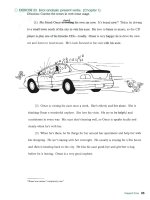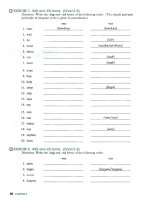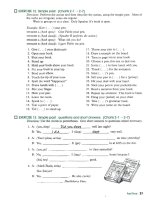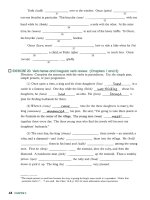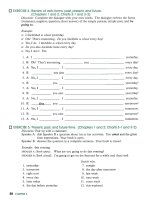Fundamentals of english grammar third edition part 20 ppsx
Bạn đang xem bản rút gọn của tài liệu. Xem và tải ngay bản đầy đủ của tài liệu tại đây (392.79 KB, 7 trang )
1
e
Will
Rob
be
here?
Es,
he
will.
(Rob will be
hen.)
No,
he
won't.
(Rob won't be here.)
I
YBS/NO
QUESTION
SHORT
ANSWER
(+
LONG
ANSWER
A
yedm
quadon
is a question that
can
be
answered by
yes
or
M.
EXERCISE
2.
Short answers to yeslno questions. (Chart
5-1)
Direceions:
In
these dialogues, the long answer is given
in
varentheses. Look at the long
(a)
Do
you
tiks
tea?
Es,
I
I.
(I
like tea.)
No,
I
don't.
(I
don't
like tea.)
@)
Did
Sue
call?
Es,
she
dtd.
(Sue called.)
No,
she
didn't.
(Sue didn't call.)
(c)
Have
you
met
Al?
Ya,
I
have.
(I
have met
AlJ
No,
I
haw&.
(I
haven't met
Al.1
(d)
Is
h
mining?
Es,
it
w.
(It's raining.)
No.
it
h't.
(It isn't
raininn.)
answer, and then write &e aipropria;e yedno aid short answer to complete each
dialogue. Do not use a negative verb
in
the question.
In
an atfvmative short answer
(yes),
a
helping verb is
NOT
contracted
with
the subject.
In
(c):
INCORRECT:
Ya,
I'm.
In
(d):
INCORRHCT:
Ya,
it's.
In
(e):
INCOKRBCT:
Ya,
he'll.
The spoken emphasis in
a
short
answer is on the verb.
1.
A:
Do
yak
kwbv
bvOtCZ~v?
B:
No,
I
Aoh't.
(I don't know your brother.)
,~
J
cClu
2.
A:
B: Yes, (Aspirin relieves
pain.)
3.
A:
B:
No, (Snakes don't have legs.)
.,:
,
.,
. .
'I
4.
A:
B:
No,
-
.
(Snakes can't mwe backward.)
5.
A:
,#
B: Yes, (The United States is in North America.)
6.
A:
,
-
i
B: Uh-huh, (I enjoyed the movie.)
B: Huh-uh, (I won't be at home tonight.)
:.,
i
7.
,IL//.,,
A:-
B: Yes,
-
-
,
,iJ.i
8:
yes,
.I
.,
>a
(Paul has left.)
10.
A:
B: Yes, (He left with Kate.)
f
EXERCISE
3.
Short answers to yeslno questions. (Chart
5-1)
Dmctions:
Work in groups of three.
Speaker
A.
Whisper the cue to Speaker B. Your book is open.
Speaker B: Ask a yeslno question using the information Speaker
A
gave you. Your book is
closed.
Speaker
C:
Give a short answer to the question. Your book is closed.
,
>
,
:
'
.
j
-
,
Enample:
(
.
. .
)
is wearing jeans today.
.*:,;,t
, :
.I"
,.
SPEAKER
A
@oak
open):
Rosa is wearing jeans today.
(whispered)
,
,
~
, ,
SPEAKER
B
(book closed):
IS
Rosa wear* jeans today?
,
.
,
,
SPEAKER
c
(book closed):
Yes, she is.
'
'1
.~
.
.,
.,!Or4
9
>,,
,
Switch
roles.
1.
(
.
.
.
)
has curly hair.
9.
(
.
. .
)
is wearing earrings.
2.
(
.
. .
)
doesn't have a mustache.
3.
(
.
. .
)
is sitting down.
4.
Isn't talking to
(
. . .
)
'
,
Switch
roles.
5.
(
. . .
)
and
(
.
.
.
)
were in class yesterday.
6.
This exercise is easy.
7.
That book belongs to
(
.
.
.
)
8.
An
ostrich can't
flv.
10.
This book has an index.
11.
(
. .
.
)'s grammar book isn't open.
12.
Gies don't eat meat.
r.,
.
-
*In
American
English,
a
form of
do
is
usually used when
haw
is
the
main
verb:
Doyou
hm
a
car?
~.,,-1i2f
[
2
In
British English,
n
form of
da
with
main
wb
haw
is
not necessary:
How
you
a
can'
122
CHAPTER
5
)
5-2
YESINO QUESTIONS
AND
INFORMATION
QUESTIONS
A
yeslno question
=
a question that can be answered by "yes" or "no."
A:
Does Ann
liwe
in Montrenl!
B:
Yo,
she
does.
OR
No, she doesn't.
An
information question
=
a question that asks for information by using
a
question word:
where, when,
why, who, whom, what, which, whose, how.
A:
-Where
does
~nnliw?
B:
In Montreal.
I
(QUES~ON
PIELPING
(REST
OF
WORD)
I
VERB
I
sLW6cT SENTENCE)
Ann
Ann
Sara
Sara
YOU
YOU
they
hey
Hkdi
Hkdi?
live
in Montreal?
liwe?
studying
at the library?
studying?
gmduate
next year?
graduate?
see
Jack?
see?
at home?
Who
came
to dinner?
Whac
happsned
yesterday?
I
*See
Chart
5-4,
p.
125,
for
a
discussion
of
who(m).
The same subject-verb word
order is used
in
both yeslno and
information questions.
HELPING
VERB
f
SUBJECT
+
MAIN
VERB
(a) is a yeslno question.
@)
is
an
information question.
In (i) and
0):
Main verb
be
in
simple present and simple past
(am,
is,
are,
was,
were)
precedes the subject. It has the
same position as a helping verb.
When the question word !e.g.,
who
or
what)
is the subject of
the question, usual question
word order is not used. No
form of
do
is used. Notice (k)
and
0).
EXERCISE
4.
Yeslno and lnforrnatlon
questions.
(Chart
5-2)
Dtrections:
Review the patterns of yestno and information questions.
Speaker
A:
Create a yestno question.
<
I
Speaker
B:
Create
an
information question using
where.
I
I
Example:
I
live there.
SPEAKER
A:
DO
YOU
live there?
SPEAKER
B:
Where do you live?
1.
She lives there.
2.
The students live there.
3.
Bob lived there.
4.
Mary is living there.
5.
1
was living there.
6.
They are going to live there.
7.
John will live there.
8.
The students can live there.
9.
Jim
has lived there.
10.
Tom has been living there.
Asklng
Questions
123
-3
WHCKb, WH
U,
WHENy
U,lJ
WHAI IIMO
QLIRSTION
A
!R
(a)
Where
did you go?
Pans.
(b)
Why
did you stay home?
Because
I
diddt feel well.*
Seven-thirty.
(c)
What
Lims
did he come?
Around five o'clock.
A
quarter past ten.
I
Seven-thirty.
Last night.
(d)
When
did he come?
no
days
ago.
Monday morning.
In
1998.
Where
asks about
place.
Why
ash about
wason.
A
question
with
what
time
asks
about
rim
on
a
dock.
A
question
with
when
can be
answered by any time expression, as in
the sample answers
in
(d).
'See
Chart
8-6,
p
239,
for
the
use
of
bacause.
"Because
I
didn't
feel
well''
is
an
adverb clause.
It
is
not a complete
sentence.
In
this
example,
it
is
the
short
answer
m
a question.
EXERCISE
5.
Information questions. (Charts
5-2
and
5-3)
Diwctims:
Create information questions. Use
where, why, when,
or
what
the.
1.
A:
B:
Tomorrow. (I'm going to
go
downtown tomorrow.)
2.
A:
r,,
B:
At Lincoln Elementary School.
(My
children go to school at Lincoln Elementary
3.
A:
B:
At
1:lO.
(Class begins at 1:lO.)
4.
A:
B:
Four
years
ago.
(I
met the Smiths four years ago.)
5.
A:
/I
B:
It's waiting for a mouse. (The cat is staring at the hole in the wall because it's
waiting for a mouse.)
0
EXERCISE
6.
Yes/no and information questions. (Charts 5-2 and 5-3)
Directions:
Work in pairs to create dialogues. Switch roles after item
6.
Speaker
A.
Ask a question that will produce the given answer.
Speaker B: Give the short answer, and then give a long answer.
Example:
After midnight.
SPEAKER
A:
What time did you go to bed last night?
SPEAKER
B:
After midnight.
I
went to bed after midnight last night.
1.
The day before yesterday.
7.
Tomorrow afternoon.
2.
Yes,
I
do.
8.
Viet Nam.
3.
Because
I
wanted to.
9.
No,
I
can't.
4.
At
8:30.
10.
Because the weather is
.
. .
today.
5.
Yes, he is.
11.
Yeah, sure. Why not?
6.
At a grocery store.
12.
1
don't know. Maybe.
0
EXERCISE
7.
Questions with WHY. (Chart 5-3)
Directions:
Work in pairs to create dialogues. Switch roles after item
4.
Speaker
A:
Say the sentence in the book.
Speaker B: Ask "Why?" or "Why not?" and then ask the
full
why-question.
Speaker
A:
Make up an answer to the question.
Example:
I
can't go with you tomorrow.
SPEAKER
A:
I
can't go with
YOU
tomorrow.
SPEAKER
B:
Why not? Why can't you go with me tomorrow?
SPEAKER
A:
Because
I
have to study for a test.
1.
I
ate two breakfasts this morning.
5.
I'm happy today.
2.
I
don't like to ride on airplanes.
6.
I
had to call the police last night.
3.
I'm
going
to sell my guitar.
7.
I
can't explain it to you.
4.
I
didn't go to bed last night.
8.
I'm not speaking to my cousin.
-4
QUESTIONS
WITH
WHO, WHO(M),
AND
WHAT
QUESTION
ANSWER
In (a):
Who
is used as the subject (s) of a
question.
s
s
In
(b):
Who(m)
is used
as
the object
(0)
in
a
(a)
Who
came?
Someone
came. question.
Whom
is used
in
formal English.
In
everyday
o
8
o
spoken English,
who
is usually used instead of
(b)
Who(m)
did
you
see?
I
saw
someone. whom:
FORMAL:
Whom did you see?
INFOW:
Who did you see?
s
s
What
can be used as either the subject
or
the
(c)
What
happened?
Something
happened. object
in
a question.
Notice
in
(a) and (c):
When
who
or
what
is
o
8
o
used as the subject of
a
question, usual question
(d)
What
did
you
see?
I
saw
something.
word order is not used; no form of
do
is used:
CORRECT:
Who came?
INCORRECT:
who
did
come?
EXERCISE
8.
Questions wlth WHO, WHO(M), and WHAT. (Chart 5-4)
Directions:
Create questions with
who, who@),
and
what.
Write
"s"
if
the question
word is the subject. Write
"0"
if
the question word is the object.
QUESTION
ANSWER
S
s
1.
hlho
~OWS?
Someone
knows.
0
0
2.
hlhabd
dtd
YOIA
ask?
I asked
someone.
3.
Someone
knocked on the door.
4.
Sara met
someone.
5.
Mike
learned
something.
6.
Something
changed Ann's mind.
7.
Ann is talking about
someone.*
EXERCISE
9.
Questions
wlth WHO, WHO(M), and WHAT. (Chart 5-4)
Directions:
Create questions. Use
who, whom,
or
what.
1.
A:
hlhat
Aid
yoln
see?
B:
An
accident. (I saw an accident.)
2.
A.
B:
An
accident. (Mary saw an accident.)
v
WHAT
3.
A:
-
I
i'l
7
B:
Mary. (Mary saw an accident.)
*A
preposition may come
at
the
beginning
of
a
question
in
very formal English:
About
whom
(NOT
who)
h
Am
talking?
.
In
oeryday
English,
a
preposition usually does not come
at
the beginning of
a
question.
126
CHAPTER
5
5.
A:
I,
B: Mary. (Mary saw John.)
6.
A:
B:
An
accident.
(An
accident happened.)
7.
A:
B. A new coat. (Alice bought a new coat.)
8.
A:
B:
Alice. (Alice bought a new coat.)
9.
A:
B: A map of the world.
(I'm
looking at a map of the world.)
10.
A:
B:
Jane. (I'm looking at Jane.)
11.
A:
B: The secretary.
(I
talked to the secretary.)
12.
A:
B:
His problems. (Tom talked about his problems.)
'.11114.
A:
B: The teacher. (The teacher looked at the board.)
15.
A:
B: The students. (The teacher looked at the students.)
.,,;
,,
.
.
.,,
,
.
'1-
,
.
16.
A:
B:
An
amphibian. (A frog is an amphibian.)
t7
.
B:
An
animal that can live on land or
in
water.
(An
amphibian is an animal that can
,mik
,
live on land
or
in water.)
,.,:
.
.:
,,,
.
,
18.
A:
B:
Mostly insects. (Frogs eat mostly insects.)
Asking
Questions
127





